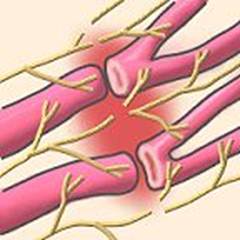 |
||||
|
||||
| 4.Mechanism behind Blood Vessel Damage in Diabetes Discovered | ||||
Researchers at Washington University School of Medicine in St. Louis have identified a key mechanism that appears to contribute to blood vessel damage in people with diabetes. The researchers said studies in mice show that the damage appears to involve two enzymes, fatty acid synthase (FAS) and nitric oxide synthase (NOS) that interact in the cells that line blood vessel walls. Researchers studied mice that had been genetically engineered to make FAS in all of their tissues except the endothelial cells that line blood vessels. These so-called FASTie mice experienced problems in the vessels that were similar to those seen in animals with diabetes. “It turns out that there are strong parallels between the complete absence of FAS and the deficiencies in FAS induced by lack of insulin and by insulin resistance,” Clay F. Semenkovich, the Herbert S. Gasser Professor of Medicine, professor of cell biology and physiology and chief of the Division of Endocrinology, Metabolism and Lipid Research said. Comparing FASTie mice to normal animals, as well as to mice with diabetes, first author Xiaochao Wei.and Semenkovich determined that mice without FAS, and with low levels of FAS, could not make the substance that anchors nitric oxide synthase to the endothelial cells in blood vessels. “Xiaochao discovered that fatty acid synthase preferentially makes a lipid that attaches to NOS, allowing it to hook to the cell membrane and to produce normal, healthy blood vessels.” In the FASTie mice, blood vessels were leaky, and in cases when the vessel was injured, the mice were unable to generate new blood vessel growth.“Our findings strongly suggest that if we can use a drug or another enzyme to promote fatty acid synthase activity, specifically in blood vessels, it might be helpful to patients with diabetes,” Wei said. |
 |
|||
| Read More | ||||
|
|
||||